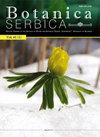Modelling the distribution of the Caucasian oak (Quercus macranthera) in Western Asia under future climate change scenarios
IF 1.1
4区 生物学
Q4 PLANT SCIENCES
引用次数: 0
Abstract
The Caucasian oak (Quercus macranthera), a native tree of Western Asia, typically grows at high altitudes where the effects of climate change are particularly notable. We analysed the climatic determinants of the current distribution of Q. macranthera and assessed the redistribution of areas suitable for this species as a consequence of climate change. We described the current range of distribution and predicted the potential geographical distribution of the Caucasian oak using species distribution models and five algorithms from two Shared Socio-Economic Pathways (SSPs: SSP 1-2.6 and 5-8.5) for the years 2035, 2055, and 2085, which are based on two General Circulation Models (GCMs). The Random Forest algorithm most accurately described the current distribution of Q. macranthera. SSP 1-2.6 and SSP5-8.5 predicted a pronounced contraction of the highly suitable habitat for the Caucasian oak due to the increase in temperatures and changes in seasonal precipitation dynamics, that more intensive climate change could lead to a greater loss of highly suitable habitats, and that the populations of Q. macranthera could survive only in the Alborz Mountains (northern Iran) and in the Great Caucasus Mountains. Our work helps to establish conservation strategies for species monitoring in order to minimise the potential impacts of climate change.未来气候变化情景下西亚高加索栎分布的模拟
高加索橡树(Quercus macranthera)是西亚的一种原生树种,通常生长在气候变化影响特别明显的高海拔地区。我们分析了影响黑桫椤当前分布的气候因素,并评估了气候变化对该物种适宜分布地区的影响。基于两种环流模型(GCMs),利用物种分布模型和两种共享社会经济路径(SSP: SSP 1-2.6和SSP 5-8.5)的5种算法,对2035年、2055年和2085年高加索栎的分布现状进行了描述,并预测了潜在的地理分布。随机森林算法最准确地描述了Q. macranthera的当前分布。SSP 1-2.6和SSP5-8.5预测,由于气温升高和季节降水动态变化,高加索栎高适宜生境明显收缩,气候变化越剧烈,高适宜生境损失越大,黑栎种群只能在伊朗北部的阿尔博斯山脉和大高加索山脉生存。我们的工作有助于建立物种监测的保护策略,以尽量减少气候变化的潜在影响。
本文章由计算机程序翻译,如有差异,请以英文原文为准。
求助全文
约1分钟内获得全文
求助全文
来源期刊

Botanica Serbica
Agricultural and Biological Sciences-Plant Science
CiteScore
1.40
自引率
12.50%
发文量
17
审稿时长
34 weeks
期刊介绍:
Botanica Serbica publishes original research papers on all aspects of plant, fungal and microbial biology research including the disciplines of microbiology, mycology, lichenology, bryology, flora, vegetation, biogeography, systematics, taxonomy, plant biotechnology, plant cell biology, plant ecology, environmental plant biology, forestry, genomics, horticulture, limnology, metabolomics, molecular biology, proteomics, virology, plant conservation and protection, and wildlife and ecosystem management.
 求助内容:
求助内容: 应助结果提醒方式:
应助结果提醒方式:


